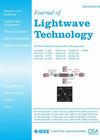Microwave Photonic Frequency Measurement With Large Bandwidth Enabled by Multiple Frequency-to-Time Mapping Curves
IF 4.8
1区 工程技术
Q2 ENGINEERING, ELECTRICAL & ELECTRONIC
引用次数: 0
Abstract
A microwave photonic frequency measurement system with a large bandwidth enabled by multiple frequency-to-time mapping (FTTM) curves is proposed and demonstrated. The optical sideband of the signal under test (SUT) is simultaneously mixed with the multiple frequency-sweeping optical sidebands generated from a semiconductor laser working in the period-one state. Multiple FTTM curves are achieved in a single channel due to the use of multiple frequency-sweeping optical sidebands and the square-law detection feature of the photodetector. The mixing products then pass through an electrical bandpass filter and an envelope detector to obtain electrical pulses at low speed. Multiple FTTM curves are exploited jointly to map the frequency of the SUT to the number and time locations of the generated electrical pulses, which can be captured with a low sampling rate. In this way, without introducing complex structures, the measurement bandwidth of the system can be effectively increased while guaranteeing the time and frequency resolutions. In a proof-of-concept experiment, four FTTM curves are realized by using the −1st and the −2nd-order frequency-sweeping optical sidebands. The instantaneous measurement bandwidth is extended to 39.8 GHz, with the working frequency range from 7.6 to 47.4 GHz and a root-mean-square error of 35 MHz. The frequency resolution is better than 50 MHz when the sweeping period is 50 μs.多重频率-时间映射曲线实现大带宽微波光子频率测量
提出并演示了一种利用多频时映射(FTTM)曲线实现大带宽的微波光子频率测量系统。被测信号的光边带与工作在1周期状态的半导体激光器产生的多个扫频光边带同时混合。由于使用了多个扫频光学边带和光电探测器的平方律检测特性,在单个通道中实现了多个FTTM曲线。混合产物然后通过电带通滤波器和包络检测器以获得低速电脉冲。利用多个FTTM曲线将SUT的频率映射到产生的电脉冲的数量和时间位置,从而可以以低采样率捕获电脉冲。这样在不引入复杂结构的情况下,在保证时间和频率分辨率的前提下,有效地提高了系统的测量带宽。在概念验证实验中,利用- 1阶和- 2阶扫频光学边带实现了4条FTTM曲线。瞬时测量带宽扩展到39.8 GHz,工作频率范围为7.6 ~ 47.4 GHz,均方根误差为35 MHz。扫描周期为50 μs时,频率分辨率优于50 MHz。
本文章由计算机程序翻译,如有差异,请以英文原文为准。
求助全文
约1分钟内获得全文
求助全文
来源期刊

Journal of Lightwave Technology
工程技术-工程:电子与电气
CiteScore
9.40
自引率
14.90%
发文量
936
审稿时长
3.9 months
期刊介绍:
The Journal of Lightwave Technology is comprised of original contributions, both regular papers and letters, covering work in all aspects of optical guided-wave science, technology, and engineering. Manuscripts are solicited which report original theoretical and/or experimental results which advance the technological base of guided-wave technology. Tutorial and review papers are by invitation only. Topics of interest include the following: fiber and cable technologies, active and passive guided-wave componentry (light sources, detectors, repeaters, switches, fiber sensors, etc.); integrated optics and optoelectronics; and systems, subsystems, new applications and unique field trials. System oriented manuscripts should be concerned with systems which perform a function not previously available, out-perform previously established systems, or represent enhancements in the state of the art in general.
 求助内容:
求助内容: 应助结果提醒方式:
应助结果提醒方式:


